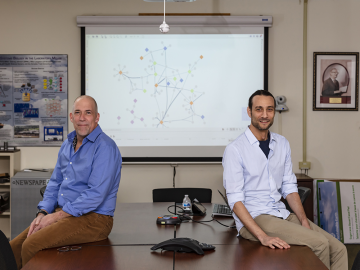
Filter News
Area of Research
- (-) Biology and Environment (49)
- (-) Functional Materials for Energy (1)
- Advanced Manufacturing (8)
- Biological Systems (1)
- Building Technologies (2)
- Computational Biology (2)
- Computational Engineering (2)
- Computer Science (9)
- Electricity and Smart Grid (1)
- Energy Science (136)
- Energy Sciences (1)
- Fuel Cycle Science and Technology (1)
- Fusion and Fission (30)
- Fusion Energy (11)
- Isotope Development and Production (1)
- Isotopes (27)
- Materials (61)
- Materials for Computing (9)
- National Security (34)
- Neutron Science (28)
- Nuclear Science and Technology (39)
- Nuclear Systems Modeling, Simulation and Validation (1)
- Quantum information Science (3)
- Supercomputing (68)
- Transportation Systems (2)
News Topics
- (-) Artificial Intelligence (10)
- (-) Biomedical (16)
- (-) Cybersecurity (1)
- (-) Isotopes (2)
- (-) Nuclear Energy (1)
- (-) Transportation (3)
- 3-D Printing/Advanced Manufacturing (11)
- Advanced Reactors (1)
- Big Data (10)
- Bioenergy (46)
- Biology (74)
- Biotechnology (14)
- Buildings (3)
- Chemical Sciences (12)
- Clean Water (11)
- Composites (5)
- Computer Science (19)
- Coronavirus (13)
- Critical Materials (1)
- Energy Storage (9)
- Environment (92)
- Exascale Computing (4)
- Frontier (4)
- Fusion (1)
- Grid (4)
- High-Performance Computing (21)
- Hydropower (8)
- Machine Learning (10)
- Materials (14)
- Materials Science (7)
- Mathematics (4)
- Mercury (7)
- Microscopy (10)
- Molten Salt (1)
- Nanotechnology (7)
- National Security (3)
- Neutron Science (4)
- Partnerships (6)
- Physics (2)
- Polymers (2)
- Security (2)
- Simulation (16)
- Summit (10)
Media Contacts

Scientists at ORNL have confirmed that bacteria-killing viruses called bacteriophages deploy a sneaky tactic when targeting their hosts: They use a standard genetic code when invading bacteria, then switch to an alternate code at later stages of

A DNA editing tool adapted by Oak Ridge National Laboratory scientists makes engineering microbes for everything from bioenergy production to plastics recycling easier and faster.

Three scientists from the Department of Energy’s Oak Ridge National Laboratory have been elected fellows of the American Association for the Advancement of Science, or AAAS.

Seven scientists at the Department of Energy’s Oak Ridge National Laboratory have been named Battelle Distinguished Inventors, in recognition of their obtaining 14 or more patents during their careers at the lab.

Researchers at Oak Ridge National Laboratory have identified a key need for future hydropower innovations – full-scale testing – to better inform developers and operators before making major investments.

ORNL researchers discovered genetic mutations that underlie autism using a new approach that could lead to better diagnostics and drug therapies.

Millions of miles of pipelines and conduits across the United States make up an intricate network of waterways used for municipal, agricultural and industrial purposes.

Tomás Rush began studying the mysteries of fungi in fifth grade and spent his college intern days tromping through forests, swamps and agricultural lands searching for signs of fungal plant pathogens causing disease on host plants.

ORNL has provided hydropower operators with new data to better prepare for extreme weather events and shifts in seasonal energy demands caused by climate change.

Researchers at the Department of Energy’s Oak Ridge National Laboratory and their technologies have received seven 2022 R&D 100 Awards, plus special recognition for a battery-related green technology product.


